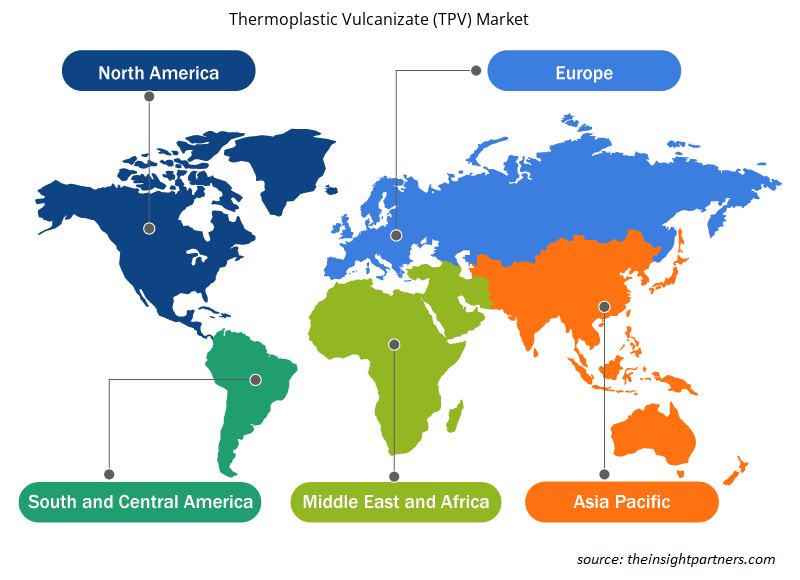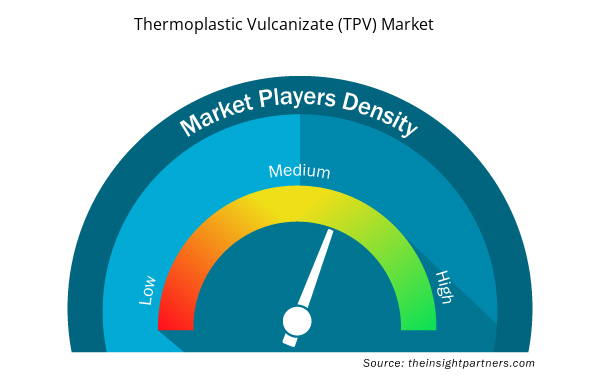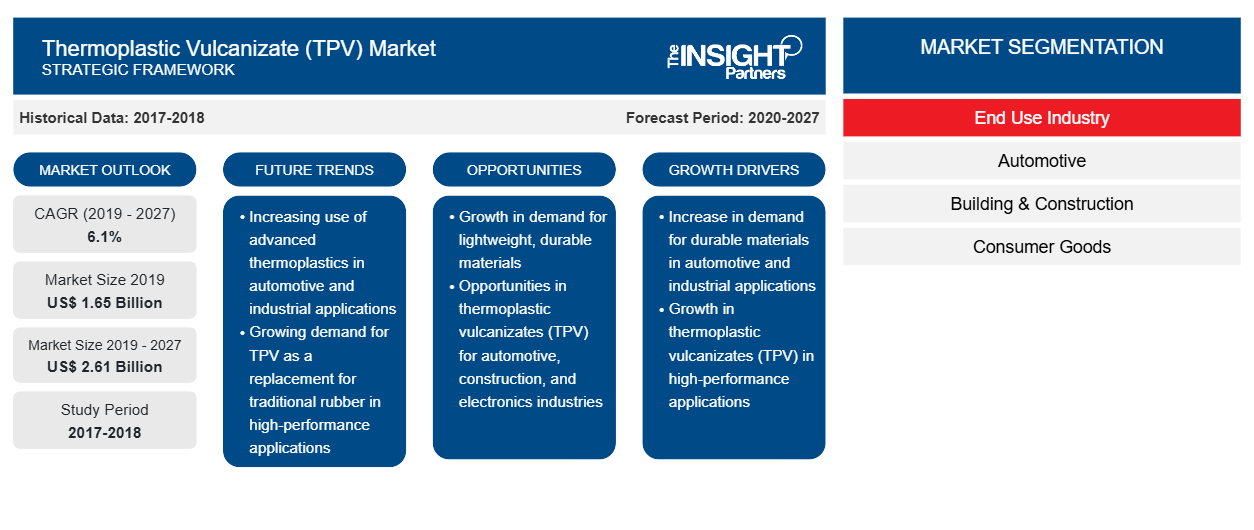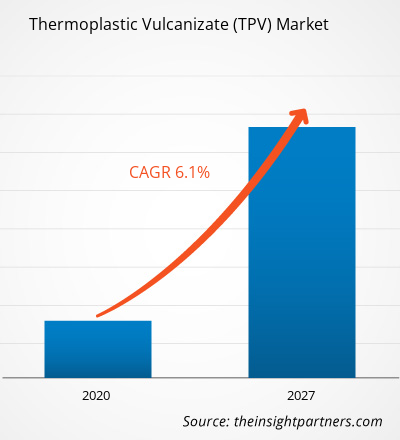Il mercato del vulcanizzato termoplastico (TPV) è stato valutato 1.646,78 milioni di dollari USA nel 2019 e si prevede che raggiungerà i 2.612,50 milioni di dollari USA entro il 2027; si prevede una crescita a un CAGR del 6,1% durante il periodo di previsione.
I vulcanizzati termoplastici sono utilizzati in un'ampia gamma di prodotti come lavatrici e asciugatrici, lavastoviglie, piccoli elettrodomestici, impugnature e guarnizioni e frigoriferi, per parti rigide e guarnizioni. Si prevede che la domanda di vulcanizzati termoplastici nel settore dei beni di consumo aumenterà grazie ai suoi vantaggi di materiali leggeri, versatili e morbidi in diverse aree di applicazione, tra cui abbigliamento, elettrodomestici, prodotti per la cura della persona, utensili da cucina ed elettroutensili. Inoltre, si prevede che la crescita dell'industria dei beni di consumo nelle nazioni BRIC avrà un impatto positivo anche sul mercato dei vulcanizzati termoplastici. Le vulcanizzazioni termoplastiche (TPV) offrono un'eccellente efficienza, costi di sistema ridotti e potenziale sostenibilità. Grazie a questi vantaggi, i TPV sono utilizzati nel settore dei beni di consumo. Ad esempio, ExxonMobil Chemical produce vulcanizzati termoplastici (TPV) con elastomeri ad alte prestazioni che offrono versatilità nella produzione, facilità di lavorazione e durata. Garantendo prestazioni superiori e costanti in applicazioni industriali e di consumo complesse, il TPV offre il potenziale per ridurre i costi dei dispositivi, il peso ridotto e la riciclabilità rispetto a materiali come EPDM (struttura portante in etilene propilene diene polimetilene) o altre gomme termoindurenti.
Si prevede che il Nord America deterrà la quota maggiore del mercato globale del vulcanizzato termoplastico (TPV) durante il periodo di previsione. Diverse aziende nazionali e internazionali hanno una solida posizione nella regione nordamericana. La crescita del mercato del vulcanizzato termoplastico (TPV) in questa regione è principalmente attribuita alla crescente domanda di materiali leggeri per la produzione di diversi componenti per auto. Inoltre, le normative governative favorevoli relative al consumo di TPV nelle applicazioni automobilistiche come alternativa a leghe e metalli, insieme all'aumento della produzione di autovetture negli Stati Uniti e in Messico, dovrebbero alimentare ulteriormente la crescita del mercato regionale nel periodo di previsione. Inoltre, gli sviluppi tecnici e la crescente domanda di veicoli elettrici hanno aumentato la necessità di beni leggeri, robusti e riciclabili, che, a loro volta, hanno spinto la crescita del mercato.
Stati Uniti, India, Brasile, Russia, Francia, Regno Unito, Turchia, Italia e Spagna sono tra le nazioni più colpite in termini di casi confermati e decessi segnalati a causa del COVID-19, a dicembre 2020. Secondo i dati dell'OMS a dicembre 2020, sono stati segnalati circa 80.453.105 casi confermati e 1.775.776 decessi nel mondo. La pandemia di COVID-19 ha colpito le economie a causa di blocchi, divieti di viaggio e chiusure aziendali. L'industria chimica e dei materiali globale è una delle principali attività che subisce interruzioni della catena di fornitura e interruzioni della produzione a causa di queste restrizioni. La Cina è il polo manifatturiero globale e il più grande fornitore di materie prime per vari settori. Il blocco di vari impianti e fabbriche nelle principali regioni, come Asia Pacifico ed Europa, sta influenzando le catene di fornitura globali e ha un impatto negativo sulla produzione, sui programmi di consegna e sulle vendite dei prodotti. Questi fattori hanno influenzato negativamente la crescita del mercato globale del vulcanizzato termoplastico (TPV).
Personalizza questo report in base alle tue esigenze
Riceverai la personalizzazione gratuita di qualsiasi report, comprese parti di questo report, o analisi a livello nazionale, pacchetto dati Excel, oltre a usufruire di grandi offerte e sconti per start-up e università
- Scopri le principali tendenze di mercato in questo rapporto.Questo campione GRATUITO includerà analisi di dati che spaziano dalle tendenze di mercato alle stime e alle previsioni.
Approfondimenti di mercato
Utilizzo di vulcanizzato termoplastico di origine biologica
Per ridurre al minimo la dipendenza da risorse non rinnovabili, come il petrolio, e per raggiungere uno sviluppo sostenibile dell'industria dei materiali polimerici, un gran numero di persone preferisce i materiali polimerici di origine biologica. I vulcanizzati termoplastici di origine biologica (TPV) sono realizzati in polilattide (PLA) e gomma etilene-co-vinilacetato (EVA) che sono stati fabbricati utilizzando perossido di dicumile (DCP) come agente di indurimento; è la prima volta che è stata dimostrata l'applicazione di PLA in materiali elastici. Poiché i TPV di origine biologica contengono basse emissioni di carbonio e sono biodegradabili in natura, la loro sintesi è incoraggiata nella maggior parte dei paesi. Sono attualmente considerati alternative sostenibili ai tradizionali polimeri di origine petrolifera poiché sono derivati da risorse rinnovabili come polimeri a base di amido, polilattidi (PLA), poliidrossialcanoati (PHA), polimeri a base di cellulosa e polimeri a base di soia. Poiché i TPE di origine biologica non solo forniscono una soluzione pulita, ma offrono anche ai produttori di TPE di origine biologica una competitività in termini di costi rispetto alle loro controparti sintetiche, si prevede che creeranno significative opportunità di crescita del mercato.
Approfondimenti sul settore dell'uso finale
In base al settore di utilizzo finale, il mercato dei materiali termoplastici vulcanizzati (TPV) è suddiviso in automotive, edilizia e costruzioni, beni di consumo, sanità e altri. Nel 2019, il segmento automotive ha dominato il mercato. I materiali leggeri per l'automotive hanno registrato una forte crescita negli ultimi anni a causa della crescente domanda di veicoli di lusso, a basse emissioni, sicuri e ad alte prestazioni. Di conseguenza, fornitori e produttori hanno lanciato una serie di soluzioni che non solo aiutano gli OEM a rispettare le severe normative, ma soddisfano anche la gamma crescente di richieste personali dei clienti. I TPV sono anche un'alternativa ragionevole agli elastomeri costosi. Offrono un'eccellente durata elastomerica, tra cui una resistenza alla trazione relativamente elevata e un allungamento al momento della rottura, un elevato recupero elastico e una buona stabilità dimensionale nell'aria calda, nonché un'eccellente resistenza all'invecchiamento da UV, all'ozono e agli agenti atmosferici. Le principali applicazioni del TVP nel settore automobilistico includono coperture per tubi flessibili, coperture per condotti di ingresso dell'aria, guarnizioni, tenute, soffietti contorti, smorzatori di vibrazioni, coperture per montanti, parti di accensione, boccole e guarnizioni per finestrini. I componenti flessibili TPV per autoveicoli sotto il cofano includono tubi di aspirazione dell'aria e soffietti, svasature del pozzetto della ruota, soffietti del sistema di sterzo e parti di insonorizzazione. Inoltre, il costo dei TPV è considerato inferiore del 10-30% rispetto all'EPDM, combinato con un peso inferiore, una maggiore versatilità di progettazione e riciclabilità.
Mitsui Chemicals Inc., Celanese Corporation, Mitsubishi Chemical Corporation, Kumho Polychem, Trinseo, Teknor Apex, ExxonMobil, Zeon Chemicals LP, Alphagary e Ravago sono tra i principali attori presenti nel mercato globale del vulcanizzato termoplastico (TPV). Queste aziende stanno implementando lo sviluppo di nuovi prodotti e strategie di fusione e acquisizione per ampliare la rispettiva clientela e ottenere una quota di mercato significativa nel mercato globale, il che, a sua volta, consente loro di mantenere il proprio marchio.
Segnala i riflettori
- Tendenze industriali progressive nel mercato globale del vulcanizzato termoplastico (TPV) che aiutano gli operatori a sviluppare strategie efficaci a lungo termine
- Strategie di crescita aziendale adottate dai mercati sviluppati e in via di sviluppo
- Analisi quantitativa del mercato globale dei vulcanizzati termoplastici (TPV) dal 2017 al 2027
- Stima della domanda globale di vulcanizzato termoplastico (TPV) in vari settori
- Analisi PEST per illustrare l'efficacia degli acquirenti e dei fornitori che operano nel settore
- Sviluppi recenti per comprendere lo scenario competitivo del mercato e la domanda globale di vulcanizzato termoplastico (TPV)
- Tendenze e prospettive di mercato, e fattori che guidano e frenano la crescita del mercato globale del termoplastico vulcanizzato (TPV)
- Comprendere le strategie che sostengono l'interesse commerciale in relazione alla crescita del mercato
- Dimensioni del mercato globale del vulcanizzato termoplastico (TPV) in vari nodi di mercato
- Panoramica dettagliata e segmentazione del mercato, nonché dinamiche del settore
- Dimensioni del mercato globale del vulcanizzato termoplastico (TPV) in varie regioni con promettenti opportunità di crescita nelle rispettive regioni
Approfondimenti regionali sul mercato dei vulcanizzati termoplastici (TPV)
Le tendenze regionali e i fattori che influenzano il mercato del vulcanizzato termoplastico (TPV) durante il periodo di previsione sono stati ampiamente spiegati dagli analisti di Insight Partners. Questa sezione discute anche i segmenti del mercato del vulcanizzato termoplastico (TPV) e la geografia in Nord America, Europa, Asia Pacifico, Medio Oriente e Africa e Sud e Centro America.

- Ottieni i dati specifici regionali per il mercato dei vulcanizzati termoplastici (TPV)
Ambito del rapporto di mercato sui vulcanizzati termoplastici (TPV)
| Attributo del report | Dettagli |
|---|---|
| Dimensioni del mercato nel 2019 | 1,65 miliardi di dollari USA |
| Dimensioni del mercato entro il 2027 | 2,61 miliardi di dollari USA |
| CAGR globale (2019 - 2027) | 6,1% |
| Dati storici | 2017-2018 |
| Periodo di previsione | 2020-2027 |
| Segmenti coperti | Per settore di utilizzo finale
|
| Regioni e Paesi coperti | America del Nord
|
| Leader di mercato e profili aziendali chiave |
|
Densità degli attori del mercato del vulcanizzato termoplastico (TPV): comprendere il suo impatto sulle dinamiche aziendali
Il mercato del vulcanizzato termoplastico (TPV) sta crescendo rapidamente, spinto dalla crescente domanda degli utenti finali dovuta a fattori quali l'evoluzione delle preferenze dei consumatori, i progressi tecnologici e una maggiore consapevolezza dei vantaggi del prodotto. Con l'aumento della domanda, le aziende stanno ampliando le loro offerte, innovando per soddisfare le esigenze dei consumatori e capitalizzando sulle tendenze emergenti, il che alimenta ulteriormente la crescita del mercato.
La densità degli operatori di mercato si riferisce alla distribuzione di aziende o società che operano in un particolare mercato o settore. Indica quanti concorrenti (operatori di mercato) sono presenti in un dato spazio di mercato in relazione alle sue dimensioni o al valore di mercato totale.
Le principali aziende che operano nel mercato dei vulcanizzati termoplastici (TPV) sono:
- Mitsui Chemicals, Inc.
- Società Celanese
- Mitsubishi Chemical Corporation
- Polichem di Kumho
- Trinità
Disclaimer : le aziende elencate sopra non sono classificate secondo un ordine particolare.

- Ottieni una panoramica dei principali attori del mercato dei vulcanizzati termoplastici (TPV)
Mercato dei vulcanizzati termoplastici (TPV), per settore di utilizzo finale
- Automobilistico
- Edilizia e costruzioni
- Beni di consumo
- Assistenza sanitaria
- Altri
Profili aziendali
- Azienda chimica Mitsui Inc.
- Società Celanese
- Mitsubishi Chemical Corporation
- Polichem di Kumho
- Trinità
- Teknor Apex
- ExxonMobil
- Prodotti chimici Zeon LP
- Alfagaria
- Ravago
- Analisi storica (2 anni), anno base, previsione (7 anni) con CAGR
- Analisi PEST e SWOT
- Valore/volume delle dimensioni del mercato - Globale, regionale, nazionale
- Industria e panorama competitivo
- Set di dati Excel



Report Coverage
Revenue forecast, Company Analysis, Industry landscape, Growth factors, and Trends

Segment Covered
This text is related
to segments covered.

Regional Scope
North America, Europe, Asia Pacific, Middle East & Africa, South & Central America

Country Scope
This text is related
to country scope.
Domande frequenti
The growth of the automotive segment is primarily attributed to the fact that the growing demand for luxurious, low-emission, safe, and high-performance vehicles. The key applications of TVP in the automotive industry include hose covers, air inlet duct covers, gaskets, seals, convoluted boots, vibration-dampers, strut covers, ignition parts, bushings, and window seals. Flexible TPV automotive under-the-hood components include air intake tubes and bellows, well flares of the wheel, bellows of the steering system, and sound abatement parts. All these factors are responsible for the berries segment to grow at the highest rate.
The major players operating in the global thermoplastic vulcanizate (TPV) market are Mitsui Chemicals, Inc., Celanese Corporation, Mitsubishi Chemical Corporation, Kumho Polychem, Trinseo, Teknor Apex, ExxonMobil, Zeon Chemicals L.P., Alphagary and Ravago among many others.
In 2019, the thermoplastic vulcanizate (TPV) market was predominant in North America at the global level. Surge in demand of thermoplastic vulcanizate (TPV) in various end use industries such as automotive, building & construction, consumer goods, healthcare, and others has had a noteworthy influence on the thermoplastic vulcanizate (TPV) market in North America. The market for thermoplastic vulcanizate (TPV) in North America is witnessing growth owing to the presence of well-established players such as Mitsubishi Chemical Corporation, Teknor Apex, Zeon Chemicals L.P., and others in this region. With the rise in demand for the lightweight and high-performance materials in the automotive industry in the region is expected to continue to grow over the projected period. The popularity of the thermoplastic vulcanizate (TPV) has increased within the region, particularly in US, Canada, and Mexico. Its use in chemical and materials industry has had a noteworthy influence on the thermoplastic vulcanizate (TPV) market in North America. Favorable government regulations pertaining to TPV consumption in automotive applications as an alternative to alloys and metals, along with increasing passenger car production in the U.S. and Mexico, are expected to further fuel regional market growth over the forecast period. Further, technical advances and growing demand for electric vehicles have increased the need for lightweight, robust and recyclable goods. The steady rise in electric vehicles on the roads is expected to fuel the growth of the market in North America. The market for thermoplastic vulcanizate (TPV) is picking up pace in this region, owing to the development of new manufacturing industries together with the government support to increase the industrial production in chemical and materials sector.
Trends and growth analysis reports related to Chemicals and Materials : READ MORE..
The List of Companies - Thermoplastic Vulcanizate Market
- Mitsui Chemicals, Inc.
- Celanese Corporation
- Mitsubishi Chemical Corporation
- Kumho Polychem
- Trinseo
- Teknor Apex
- ExxonMobil
- Zeon Chemicals L.P.
- Alphagary
- Ravago Manufacturing
The Insight Partners performs research in 4 major stages: Data Collection & Secondary Research, Primary Research, Data Analysis and Data Triangulation & Final Review.
- Data Collection and Secondary Research:
As a market research and consulting firm operating from a decade, we have published and advised several client across the globe. First step for any study will start with an assessment of currently available data and insights from existing reports. Further, historical and current market information is collected from Investor Presentations, Annual Reports, SEC Filings, etc., and other information related to company’s performance and market positioning are gathered from Paid Databases (Factiva, Hoovers, and Reuters) and various other publications available in public domain.
Several associations trade associates, technical forums, institutes, societies and organization are accessed to gain technical as well as market related insights through their publications such as research papers, blogs and press releases related to the studies are referred to get cues about the market. Further, white papers, journals, magazines, and other news articles published in last 3 years are scrutinized and analyzed to understand the current market trends.
- Primary Research:
The primarily interview analysis comprise of data obtained from industry participants interview and answers to survey questions gathered by in-house primary team.
For primary research, interviews are conducted with industry experts/CEOs/Marketing Managers/VPs/Subject Matter Experts from both demand and supply side to get a 360-degree view of the market. The primary team conducts several interviews based on the complexity of the markets to understand the various market trends and dynamics which makes research more credible and precise.
A typical research interview fulfils the following functions:
- Provides first-hand information on the market size, market trends, growth trends, competitive landscape, and outlook
- Validates and strengthens in-house secondary research findings
- Develops the analysis team’s expertise and market understanding
Primary research involves email interactions and telephone interviews for each market, category, segment, and sub-segment across geographies. The participants who typically take part in such a process include, but are not limited to:
- Industry participants: VPs, business development managers, market intelligence managers and national sales managers
- Outside experts: Valuation experts, research analysts and key opinion leaders specializing in the electronics and semiconductor industry.
Below is the breakup of our primary respondents by company, designation, and region:

Once we receive the confirmation from primary research sources or primary respondents, we finalize the base year market estimation and forecast the data as per the macroeconomic and microeconomic factors assessed during data collection.
- Data Analysis:
Once data is validated through both secondary as well as primary respondents, we finalize the market estimations by hypothesis formulation and factor analysis at regional and country level.
- Macro-Economic Factor Analysis:
We analyse macroeconomic indicators such the gross domestic product (GDP), increase in the demand for goods and services across industries, technological advancement, regional economic growth, governmental policies, the influence of COVID-19, PEST analysis, and other aspects. This analysis aids in setting benchmarks for various nations/regions and approximating market splits. Additionally, the general trend of the aforementioned components aid in determining the market's development possibilities.
- Country Level Data:
Various factors that are especially aligned to the country are taken into account to determine the market size for a certain area and country, including the presence of vendors, such as headquarters and offices, the country's GDP, demand patterns, and industry growth. To comprehend the market dynamics for the nation, a number of growth variables, inhibitors, application areas, and current market trends are researched. The aforementioned elements aid in determining the country's overall market's growth potential.
- Company Profile:
The “Table of Contents” is formulated by listing and analyzing more than 25 - 30 companies operating in the market ecosystem across geographies. However, we profile only 10 companies as a standard practice in our syndicate reports. These 10 companies comprise leading, emerging, and regional players. Nonetheless, our analysis is not restricted to the 10 listed companies, we also analyze other companies present in the market to develop a holistic view and understand the prevailing trends. The “Company Profiles” section in the report covers key facts, business description, products & services, financial information, SWOT analysis, and key developments. The financial information presented is extracted from the annual reports and official documents of the publicly listed companies. Upon collecting the information for the sections of respective companies, we verify them via various primary sources and then compile the data in respective company profiles. The company level information helps us in deriving the base number as well as in forecasting the market size.
- Developing Base Number:
Aggregation of sales statistics (2020-2022) and macro-economic factor, and other secondary and primary research insights are utilized to arrive at base number and related market shares for 2022. The data gaps are identified in this step and relevant market data is analyzed, collected from paid primary interviews or databases. On finalizing the base year market size, forecasts are developed on the basis of macro-economic, industry and market growth factors and company level analysis.
- Data Triangulation and Final Review:
The market findings and base year market size calculations are validated from supply as well as demand side. Demand side validations are based on macro-economic factor analysis and benchmarks for respective regions and countries. In case of supply side validations, revenues of major companies are estimated (in case not available) based on industry benchmark, approximate number of employees, product portfolio, and primary interviews revenues are gathered. Further revenue from target product/service segment is assessed to avoid overshooting of market statistics. In case of heavy deviations between supply and demand side values, all thes steps are repeated to achieve synchronization.
We follow an iterative model, wherein we share our research findings with Subject Matter Experts (SME’s) and Key Opinion Leaders (KOLs) until consensus view of the market is not formulated – this model negates any drastic deviation in the opinions of experts. Only validated and universally acceptable research findings are quoted in our reports.
We have important check points that we use to validate our research findings – which we call – data triangulation, where we validate the information, we generate from secondary sources with primary interviews and then we re-validate with our internal data bases and Subject matter experts. This comprehensive model enables us to deliver high quality, reliable data in shortest possible time.


 Ottieni un campione gratuito per questo repot
Ottieni un campione gratuito per questo repot